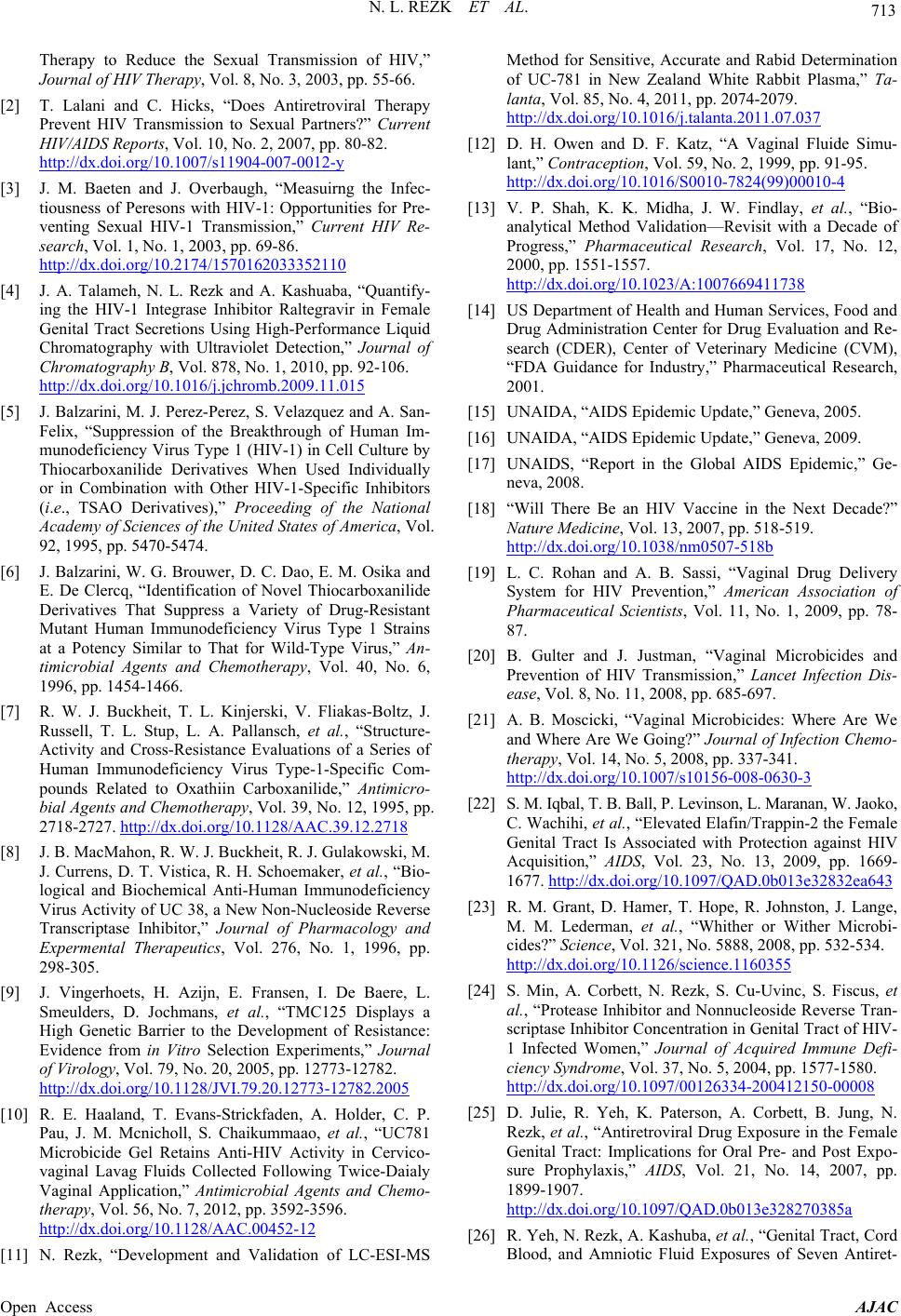
N. L. REZK ET AL. 713
Therapy to Reduce the Sexual Transmission of HIV,”
Journal of HIV Therapy, Vol. 8, No. 3, 2003, pp. 55-66.
[2] T. Lalani and C. Hicks, “Does Antiretroviral Therapy
Prevent HIV Transmission to Sexual Partners?” Current
HIV/AIDS Reports, Vol. 10, No. 2, 2007, pp. 80-82.
http://dx.doi.org/10.1007/s11904-007-0012-y
[3] J. M. Baeten and J. Overbaugh, “Measuirng the Infec-
tiousness of Peresons with HIV-1: Opportunities for Pre-
venting Sexual HIV-1 Transmission,” Current HIV Re-
search, Vol. 1, No. 1, 2003, pp. 69-86.
http://dx.doi.org/10.2174/1570162033352110
[4] J. A. Talameh, N. L. Rezk and A. Kashuaba, “Quantify-
ing the HIV-1 Integrase Inhibitor Raltegravir in Female
Genital Tract Secretions Using High-Performance Liquid
Chromatography with Ultraviolet Detection,” Journal of
Chromatography B, Vol. 878, No. 1, 2010, pp. 92-106.
http://dx.doi.org/10.1016/j.jchromb.2009.11.015
[5] J. Balzarini, M. J. Perez-Perez, S. Velazquez and A. San-
Felix, “Suppression of the Breakthrough of Human Im-
munodeficiency Virus Type 1 (HIV-1) in Cell Culture by
Thiocarboxanilide Derivatives When Used Individually
or in Combination with Other HIV-1-Specific Inhibitors
(i.e., TSAO Derivatives),” Proceeding of the National
Academy of Sciences of the United States of America, Vol.
92, 1995, pp. 5470-5474.
[6] J. Balzarini, W. G. Brouwer, D. C. Dao, E. M. Osika and
E. De Clercq, “Identification of Novel Thiocarboxanilide
Derivatives That Suppress a Variety of Drug-Resistant
Mutant Human Immunodeficiency Virus Type 1 Strains
at a Potency Similar to That for Wild-Type Virus,” An-
timicrobial Agents and Chemotherapy, Vol. 40, No. 6,
1996, pp. 1454-1466.
[7] R. W. J. Buckheit, T. L. Kinjerski, V. Fliakas-Boltz, J.
Russell, T. L. Stup, L. A. Pallansch, et al., “Structure-
Activity and Cross-Resistance Evaluations of a Series of
Human Immunodeficiency Virus Type-1-Specific Com-
pounds Related to Oxathiin Carboxanilide,” Antimicro-
bial Agents and Chemotherapy, Vol. 39, No. 12, 1995, pp.
2718-2727. http://dx.doi.org/10.1128/AAC.39.12.2718
[8] J. B. MacMahon, R. W. J. Buckheit, R. J. Gulakowski, M.
J. Currens, D. T. Vistica, R. H. Schoemaker, et al., “Bio-
logical and Biochemical Anti-Human Immunodeficiency
Virus Activity of UC 38, a New Non-Nucleoside Reverse
Transcriptase Inhibitor,” Journal of Pharmacology and
Expermental Therapeutics, Vol. 276, No. 1, 1996, pp.
298-305.
[9] J. Vingerhoets, H. Azijn, E. Fransen, I. De Baere, L.
Smeulders, D. Jochmans, et al., “TMC125 Displays a
High Genetic Barrier to the Development of Resistance:
Evidence from in Vitro Selection Experiments,” Journal
of Virology, Vol. 79, No. 20, 2005, pp. 12773-12782.
http://dx.doi.org/10.1128/JVI.79.20.12773-12782.2005
[10] R. E. Haaland, T. Evans-Strickfaden, A. Holder, C. P.
Pau, J. M. Mcnicholl, S. Chaikummaao, et al., “UC781
Microbicide Gel Retains Anti-HIV Activity in Cervico-
vaginal Lavag Fluids Collected Following Twice-Daialy
Vaginal Application,” Antimicrobial Agents and Chemo-
therapy, Vol. 56, No. 7, 2012, pp. 3592-3596.
http://dx.doi.org/10.1128/AAC.00452-12
[11] N. Rezk, “Development and Validation of LC-ESI-MS
Method for Sensitive, Accurate and Rabid Determination
of UC-781 in New Zealand White Rabbit Plasma,” Ta-
lanta, Vol. 85, No. 4, 2011, pp. 2074-2079.
http://dx.doi.org/10.1016/j.talanta.2011.07.037
[12] D. H. Owen and D. F. Katz, “A Vaginal Fluide Simu-
lant,” Contraception, Vol. 59, No. 2, 1999, pp. 91-95.
http://dx.doi.org/10.1016/S0010-7824(99)00010-4
[13] V. P. Shah, K. K. Midha, J. W. Findlay, et al., “Bio-
analytical Method Validation—Revisit with a Decade of
Progress,” Pharmaceutical Research, Vol. 17, No. 12,
2000, pp. 1551-1557.
http://dx.doi.org/10.1023/A:1007669411738
[14] US Department of Health and Human Services, Food and
Drug Administration Center for Drug Evaluation and Re-
search (CDER), Center of Veterinary Medicine (CVM),
“FDA Guidance for Industry,” Pharmaceutical Research,
2001.
[15] UNAIDA, “AIDS Epidemic Update,” Geneva, 2005.
[16] UNAIDA, “AIDS Epidemic Update,” Geneva, 2009.
[17] UNAIDS, “Report in the Global AIDS Epidemic,” Ge-
neva, 2008.
[18] “Will There Be an HIV Vaccine in the Next Decade?”
Nature Medici ne, Vol. 13, 2007, pp. 518-519.
http://dx.doi.org/10.1038/nm0507-518b
[19] L. C. Rohan and A. B. Sassi, “Vaginal Drug Delivery
System for HIV Prevention,” American Association of
Pharmaceutical Scientists, Vol. 11, No. 1, 2009, pp. 78-
87.
[20] B. Gulter and J. Justman, “Vaginal Microbicides and
Prevention of HIV Transmission,” Lancet Infection Dis-
ease, Vol. 8, No. 11, 2008, pp. 685-697.
[21] A. B. Moscicki, “Vaginal Microbicides: Where Are We
and Where Are We Going?” Journal of Infection Chemo-
therapy, Vol. 14, No. 5, 2008, pp. 337-341.
http://dx.doi.org/10.1007/s10156-008-0630-3
[22] S. M. Iqbal, T. B. Ball, P. Levinson, L. Maranan, W. Jaoko,
C. Wachihi, et al., “Elevated Elafin/Trappin-2 the Female
Genital Tract Is Associated with Protection against HIV
Acquisition,” AIDS, Vol. 23, No. 13, 2009, pp. 1669-
1677. http://dx.doi.org/10.1097/QAD.0b013e32832ea643
[23] R. M. Grant, D. Hamer, T. Hope, R. Johnston, J. Lange,
M. M. Lederman, et al., “Whither or Wither Microbi-
cides?” Science, Vol. 321, No. 5888, 2008, pp. 532-534.
http://dx.doi.org/10.1126/science.1160355
[24] S. Min, A. Corbett, N. Rezk, S. Cu-Uvinc, S. Fiscus, et
al., “Protease Inhibitor and Nonnucleoside Reverse Tran-
scriptase Inhibitor Concentration in Genital Tract of HIV-
1 Infected Women,” Journal of Acquired Immune Defi-
ciency Syndrome, Vol. 37, No. 5, 2004, pp. 1577-1580.
http://dx.doi.org/10.1097/00126334-200412150-00008
[25] D. Julie, R. Yeh, K. Paterson, A. Corbett, B. Jung, N.
Rezk, et al., “Antiretroviral Drug Exposure in the Female
Genital Tract: Implications for Oral Pre- and Post Expo-
sure Prophylaxis,” AIDS, Vol. 21, No. 14, 2007, pp.
1899-1907.
http://dx.doi.org/10.1097/QAD.0b013e328270385a
[26] R. Yeh, N. Rezk, A. Kashuba, et al., “Genital Tract, Cord
Blood, and Amniotic Fluid Exposures of Seven Antiret-
Open Access AJAC